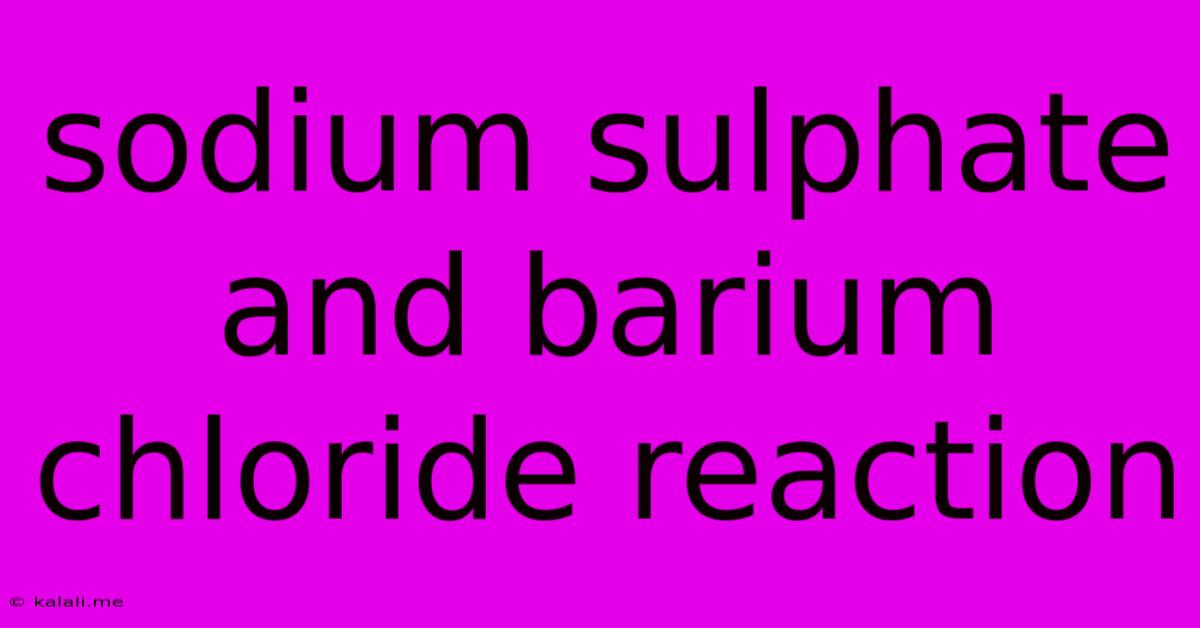Sodium Sulphate And Barium Chloride Reaction
Kalali
Jun 14, 2025 · 3 min read

Table of Contents
The Reaction Between Sodium Sulphate and Barium Chloride: A Detailed Look
This article delves into the fascinating chemical reaction between sodium sulphate (Na₂SO₄) and barium chloride (BaCl₂), explaining the process, observations, and its significance in chemistry. Understanding this reaction provides valuable insight into double displacement reactions, precipitation reactions, and the concept of solubility. We'll cover everything from the balanced equation to practical applications.
What Happens When Sodium Sulphate and Barium Chloride React?
When aqueous solutions of sodium sulphate and barium chloride are mixed, a double displacement reaction occurs, also known as a metathesis reaction. This means that the positive and negative ions of the two reactants switch partners to form two new compounds. The reaction results in the formation of barium sulphate (BaSO₄) and sodium chloride (NaCl).
The key observation is the formation of a white precipitate. This precipitate is barium sulphate, an insoluble compound in water. Sodium chloride, on the other hand, remains dissolved in the solution as it is highly soluble.
The Balanced Chemical Equation:
The balanced chemical equation for this reaction accurately reflects the stoichiometry:
Na₂SO₄(aq) + BaCl₂(aq) → BaSO₄(s) + 2NaCl(aq)
This equation shows that one mole of sodium sulphate reacts with one mole of barium chloride to produce one mole of barium sulphate precipitate and two moles of sodium chloride in solution. The "(aq)" denotes aqueous solutions, while "(s)" indicates a solid precipitate.
Understanding the Reaction Mechanism:
At a molecular level, the reaction involves the interaction of the constituent ions. In solution, sodium sulphate dissociates into sodium (Na⁺) and sulphate (SO₄²⁻) ions, while barium chloride dissociates into barium (Ba²⁺) and chloride (Cl⁻) ions. Upon mixing, the barium ions (Ba²⁺) and sulphate ions (SO₄²⁻) combine to form the insoluble barium sulphate, which precipitates out of the solution. The sodium (Na⁺) and chloride (Cl⁻) ions remain in solution as spectator ions, meaning they don't directly participate in the precipitation reaction.
Observations During the Reaction:
- Immediate Precipitation: The formation of the white barium sulphate precipitate is almost instantaneous upon mixing the two solutions.
- Cloudy Appearance: The solution becomes cloudy due to the suspension of the fine barium sulphate particles.
- Sedimentation: Over time, the barium sulphate precipitate settles at the bottom of the container.
- Clear Supernatant: The liquid above the precipitate (supernatant) will appear clear, indicating the solubility of sodium chloride.
Applications and Importance:
This reaction is significant in several areas:
- Qualitative Analysis: It's a classic example used in chemistry education to illustrate double displacement and precipitation reactions. The formation of the barium sulphate precipitate is a qualitative test for the presence of sulphate ions.
- Industrial Applications: Barium sulphate, also known as barite, finds applications as a weighting agent in drilling fluids in the oil and gas industry. It's also used as a pigment and filler in various products.
- Medical Applications: Barium sulphate is used as a contrast agent in medical imaging, specifically in X-ray examinations of the gastrointestinal tract. Its high atomic number makes it radiopaque.
Safety Precautions:
While the reaction itself is generally safe, appropriate laboratory safety precautions should always be followed. This includes wearing safety goggles and gloves to protect against splashes and potential irritants.
Conclusion:
The reaction between sodium sulphate and barium chloride is a fundamental example of a double displacement precipitation reaction. Understanding this reaction enhances our understanding of chemical reactions, solubility rules, and has practical implications in various fields. The clear observation of the white barium sulphate precipitate makes it an excellent demonstration of chemical principles in action.
Latest Posts
Latest Posts
-
What Act Score Is Needed For Mizzou
Jun 15, 2025
-
Which Tooth Has The Longest Root
Jun 15, 2025
-
Select The Correct Statement Regarding Chemical Synapses
Jun 15, 2025
-
What Is The Lcm Of 40 And 24
Jun 15, 2025
-
Substance That Speeds Up The Rate Of A Chemical Reaction
Jun 15, 2025
Related Post
Thank you for visiting our website which covers about Sodium Sulphate And Barium Chloride Reaction . We hope the information provided has been useful to you. Feel free to contact us if you have any questions or need further assistance. See you next time and don't miss to bookmark.